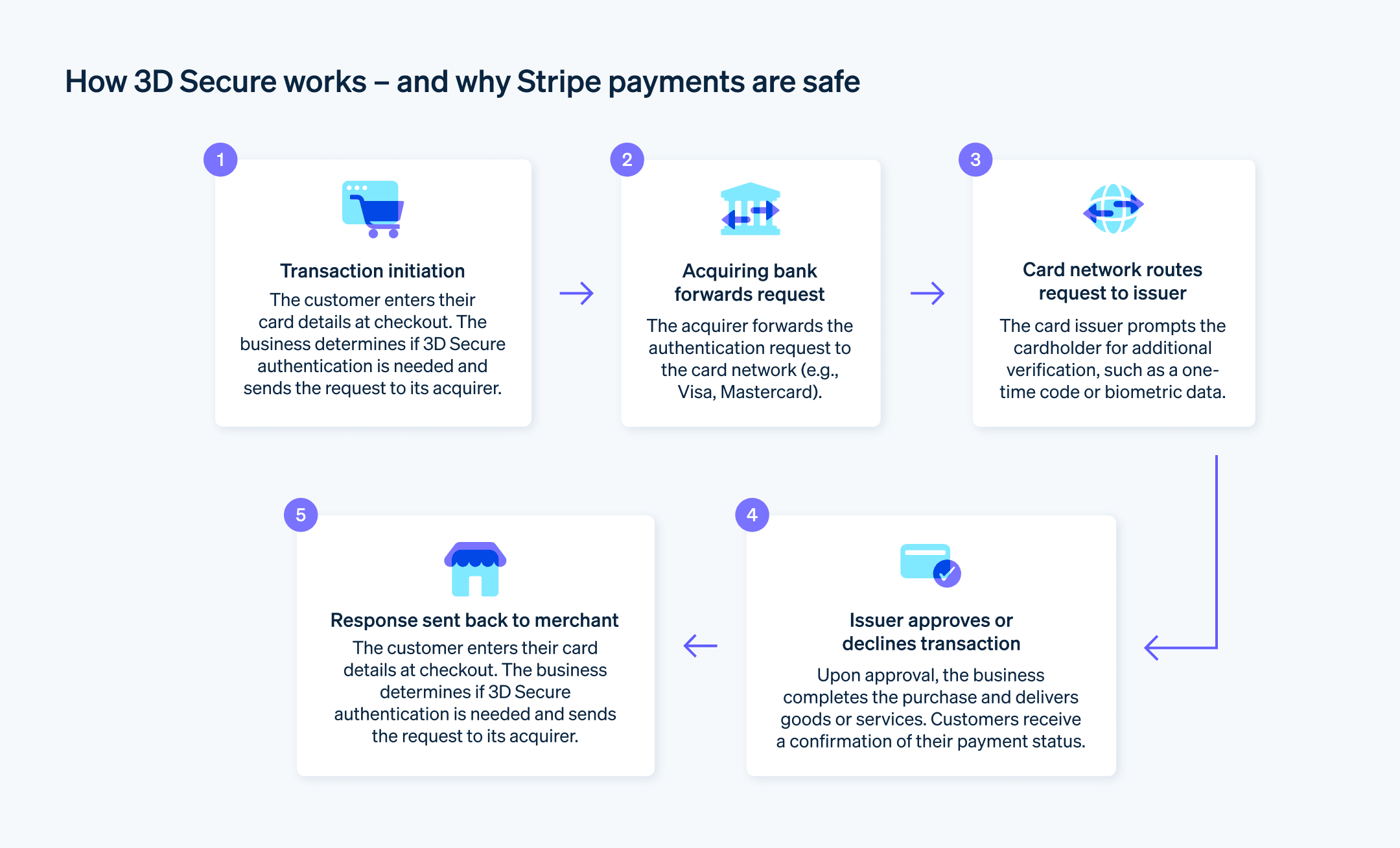随着商家的发展,对数字支付解决方案的需求也在增加,这些解决方案既能保证客户数据的安全,又不会影响他们的在线付款体验。3DS 验证是保护支付 的常用身份验证协议,是应对这一挑战的解决方案之一。在 3DS 2.0 验证中,这个成熟的框架得到了升级,重点在于更强大的防御和更流畅的客户体验。
移动和数字交易 的兴起为 3DS 2.0 验证等协议的应用铺平了道路。全球 3DS 验证支付验证市场在 2023 年的估值约为 12 亿美元。企业需要一个能与现有平台有效集成的系统,在提供强大保护的同时提升支付体验。下面,我们将解释 3DS 验证是什么、其运作机制以及企业如何实施 3DS 验证来帮助优化支付系统并满足客户需求。
本文内容
- 什么是 3DS 验证?
- 3DS 验证如何运作?
- 实施 3DS 验证的好处
- 3DS 1.0 验证与 3DS 2.0 验证
- 关于 3DS 验证的常见误解
- 3DS 验证的挑战和缺点
- 如何在支付系统中实施 3DS 验证
- Stripe Payments 如何提供帮助
什么是 3DS 验证?
3DS 验证(即“三域安全”)是一种身份验证协议,为在线信用卡和借记卡交易增加了一层额外的验证保护。该协议最初由 Visa 公司开发,名为“Visa 验证服务”。
传统交易只需要卡信息和安全代码,而 3DS 验证交易则会提示持卡人输入额外的密码、发送到其移动设备的一次性代码或生物识别验证。这一步骤通常在弹出窗口或应用程序内界面进行。
3DS 验证如何运作?
3DS 验证流程是一个多步骤、多方操作的过程,为在线交易提供了一层额外的安全保障。该协议取决于银行卡发卡行、收单行和互操作性领域之间的互动。下面我们将对该流程的每个步骤进行分解。

实施 3DS 验证的好处
降低欺诈性交易的风险
3DS 验证通过在实时交易中向客户请求额外身份验证步骤来审核交易,从而消除大多数未经授权的交易,帮助企业减少与欺诈相关的成本。更少的撤单也意味着在银行获得更有利的评级。2024 年,全球电商欺诈损失总计约为 443 亿美元,这凸显了企业所面临的欺诈交易规模之大。增强客户的信任和信心
对于购物者来说,多一层身份验证就多一份安全。这种信心的增强具有持久的好处。它可以影响客户的整个生命周期,帮助将一次性购买者转变为回头客,并将偶尔购物者转变为品牌拥护者。遵从监管标准
法律合规是数字时代开展业务的一个不可避免的部分。监管机构经常更新其指导方针,使企业难以跟上。采用 3DS 验证可帮助您保持合规性,避免巨额罚款和法律纠纷。严格合规的声誉还可以成为市场差异化的标志,为谨慎的客户提供选择您的平台而不是安全性较低的竞争对手的可靠理由。
3DS 1.0 验证与 3DS 2.0 验证
EMVCo 于 2016 年 10 月推出了 3DS 2.0 验证(从 3DS 1.0 验证)更新版,但企业、发卡行和支付网关并未立即采用和全面实施。由于几项新法规的出台,包括欧盟的《支付服务指令修订版》(PSD2) 及其对强客户认证 (SCA) 的要求,2019 年 3DS 2.0 验证的采用得到了更广泛的推动。
虽然 3DS 1.0 验证和 3DS 2.0 验证都是用于线上信用卡支付的身份验证协议,但它们在设计和客户体验上有很大不同。以下是它们的比较:
客户体验
- 3DS 1.0 验证: 客户被重定向到单独的身份验证页面,这有时会导致更混乱的结账体验。
- 3DS 2.0 验证: 此版本部分旨在提升客户体验,尽量减少结账期间的中断。通常,只有高风险交易才需要额外的身份验证。
移动集成
- 3DS 1.0 验证: 由于它未针对移动体验进行优化,因此有时会导致移动设备上的验证页面反应迟钝或显示不佳。
- 3DS 2.0 验证: 它专为移动使用而构建,针对更流畅的移动集成进行了优化,可轻松与移动应用和浏览器配合使用。
数据点
- 3DS 1.0 验证: 在身份验证过程中使用的数据点较少。
- 3DS 2.0 验证: 使用更多数据点(例如交易历史记录和设备信息)进行基于风险的评估。这允许更智能的身份验证,其中低风险交易可能不需要额外的验证。
无摩擦流程
- 3DS 1.0 验证: 通常需要持卡人提供密码或某种形式的静态身份验证。
- 3DS 2.0 验证: 引入“无摩擦流程”,无需持卡人交互即可对某些交易进行身份验证。
交易范围
监管与合规
发卡行与企业沟通
- 3DS 1.0 验证: 发卡行和企业就交易进行沟通的方式有限。
- 3DS 2.0 验证: 促进发卡行和企业之间更直接的沟通,允许根据交易风险做出实时决策。
这两种协议都为线上信用卡交易提供了安全的环境,但 3DS 2.0 验证的实施在客户体验、移动优化和自适应验证方法方面都取得了进步。这种新的迭代为在线商务提供了一个更加现代化和用户友好的解决方案。
关于 3DS 验证的常见误解
关于 3DS 验证存在一些误解,这些误解可能会影响企业实施该技术的决定。了解这些常见的误解对于做出明智的选择非常重要。下面我们来详细了解一下:
误解 1:这是一种防欺诈的解决方案
虽然 3DS 验证大大降低了欺诈交易的风险,但任何系统都不是完美无缺的。该技术更像一只训练有素的看门狗,而不是一座拥有坚不可摧城墙的堡垒。因此,一个平衡的策略应该包括多层次的安全措施,包括但不限于 3DS 验证,以最有效地打击不同欺诈活动类型。
误解 2:它减慢了交易速度
有一种看法认为,3DS 验证会给交易时间带来不必要的延误。然而,从长远来看,多花几秒钟进行身份验证可以减少需要调查欺诈行为的交易数量,从而节省时间。减少撤单费和其他欺诈相关成本的潜力可以弥补交易时间上的任何微小延迟。
误解 3:它仅适用于高风险行业
有些人认为,3DS 验证只对奢侈品或在线赌博等行业有利,因为这些行业的高额交易非常普遍。然而,事实并非如此。许多不同行业的企业都可以从增加的安全性中获益,即使不是在高风险行业经营的企业也是如此。3DS 验证就像一份保险单:拥有它而不需要它,总比需要它而没有它要好。
3DS 验证的挑战和缺点
虽然 3DS 验证有很多好处,但企业在实施这项技术时也可能面临挑战和不足之处。
增加结账阻力
在结账流程中引入 3DS 验证而不增加额外障碍是一项挑战。您不希望客户因为遇到繁琐的身份验证流程而退出交易流程。虽然 3DS 验证的初衷是增加一层安全性,但如果客户认为这是一种不便,他们就不太可能完成购买。客户体验的复杂性
在结账流程中添加多个步骤可能会导致客户体验的复杂性。支付流程越不直观,客户放弃它的可能性就越大。支付体验应尽可能顺畅,同时保持必要的安全措施,而 3DS 验证的加入有时会对保持这种平衡带来挑战。运营需求
实施 3DS 验证通常意味着对现有系统和流程进行更改。这可能涉及更新 IT 基础设施和员工培训,以及确保客户服务代表具备处理相关询问的能力。最初的时间和资源投资可能相当可观,这可能会阻碍一些企业采用该技术。责任问题
虽然 3DS 验证会将欺诈性交易的部分责任从企业转移出去,但有关这种转移的条件和条款可能很复杂。并非所有欺诈情况都包括在内,企业必须在采取反欺诈措施时保持警惕。错位的安全感可能会使企业变得不那么谨慎,这可能会产生不利的长期影响。
尽管 3DS 验证有其潜在的挑战,但正确的规划可以抵消这些问题。对于企业来说,一种选择是与 Stripe 等强大、全面的支付服务商合作。
如何在支付系统中实施 3DS 验证
将 3DS 验证纳入您的支付系统可增加一个额外的安全层,作为防止欺诈交易的预防措施。Stripe 提供对 3DS 2.0 验证的全面支持,3DS 2.0 验证是该安全协议的高级版本,对用户更友好。以下是实施过程中需要考虑的一些事项:
与 Stripe 的 API 集成
Stripe 通过其支付 API 和 Checkout 功能为 3DS 2.0 验证提供便利。将这些工具集成到您的系统中可以保护高风险交易免受潜在的欺诈。使用 Stripe 集成的一个关键优势是,它可以在持卡人的银行支持时应用 3DS 2.0 验证,并在必要时恢复到 3DS 1.0 验证。关注移动应用
移动端应用需要顺畅的交易流程。Stripe 的 iOS 和 Android SDK 支持应用内身份验证,为客户创造更直接的体验。这样可以防止客户被重定向到外部页面,从而中断支付流程。即使银行不支持 3DS 2.0 验证,Stripe 的移动 SDK 也会在嵌入应用的网页视图中展示 3DS 1.0 验证。优先考虑客户体验
3DS 2.0 验证的开发考虑到了智能手机,允许银行更新其验证方法。例如,客户可以使用指纹或面部 ID 验证付款,而不是传统的密码或短信。这一新技术可提供更好的交易体验,减少交易中断。采用网络和移动结账流程
3DS 2.0 验证的设计将质询流程嵌入到 Web 和移动结账中,无需整页重定向。如果客户在您的网站或应用上确认了他们的身份,他们将在结账页面的模式中看到 3DS 验证提示。随时了解法规
如果您在欧洲开展业务,那么实施强客户认证 (SCA) 是关键。SCA 要求对欧洲支付进行更严格的身份验证,使 3DS 2.0 验证的客户体验变得无价。通过使用 3DS 2.0 验证,企业可以更大限度地减少对转化率的任何潜在负面影响。利用 3DS 2.0 验证的灵活性
Stripe 对 3DS 2.0 验证协议的适应性允许某些交易跳过身份验证并使用“无摩擦”流程,尤其是在它们被视为低风险的情况下。但是,如果支付服务商要求豁免,并且交易使用“无摩擦”方法,责任转移的好处可能就不适用了。
将 3DS 2.0 验证整合到支付系统中有助于防止欺诈,同时确保支付体验尽可能用户友好。通过利用 Stripe 的工具并遵循上述准则,企业可以实现安全性和可用性的平衡组合。
Stripe Payments 如何提供帮助
Stripe Payments 提供一体化的全球支付解决方案,帮助任何企业——从成长型初创公司到全球性企业——在全球范围内接受线上和线下付款。
Stripe Payments 可帮您:
- 优化结账体验: 通过预构建的支付用户界面、超过 125 种支付方式以及 Stripe 的数字钱包 Link,营造顺畅的客户体验,并节省数千个小时的工程时间。
- 更快地拓展新市场: 覆盖全球客户,并通过跨境支付选项降低多币种管理的复杂性和成本,服务覆盖 195 个国家、支持 135 种以上的货币。
- 整合线下与线上付款: 整合线上与线下渠道,打造统一的商务体验,实现个性化互动、回馈忠实客户并增加收入。
- 优化支付性能: 通过一系列可定制、易于配置的支付工具提升收入,包括无代码的欺诈保护功能与提高授权率的高级功能。
- 依托灵活可靠的平台加速业务增长: 采用专为弹性扩展设计的平台架构,提供 99.999% 正常运行时间与业界领先的可靠性保障。
了解关于 Stripe Payments 如何助力线上与实体支付业务的更多信息,或立即开始使用。
本文中的内容仅供一般信息和教育目的,不应被解释为法律或税务建议。Stripe 不保证或担保文章中信息的准确性、完整性、充分性或时效性。您应该寻求在您的司法管辖区获得执业许可的合格律师或会计师的建议,以就您的特定情况提供建议。